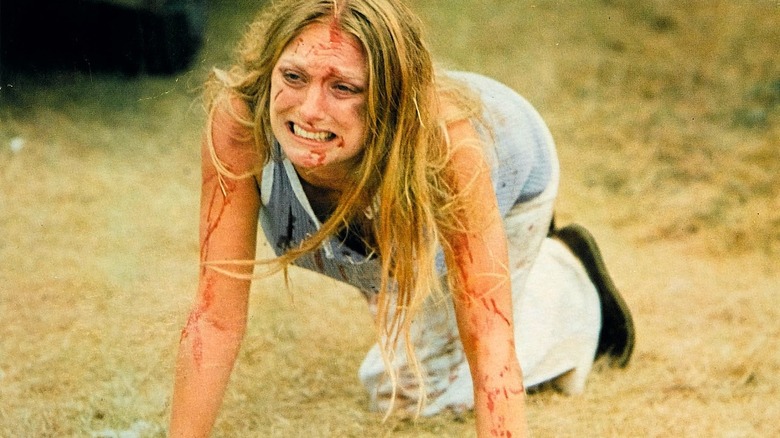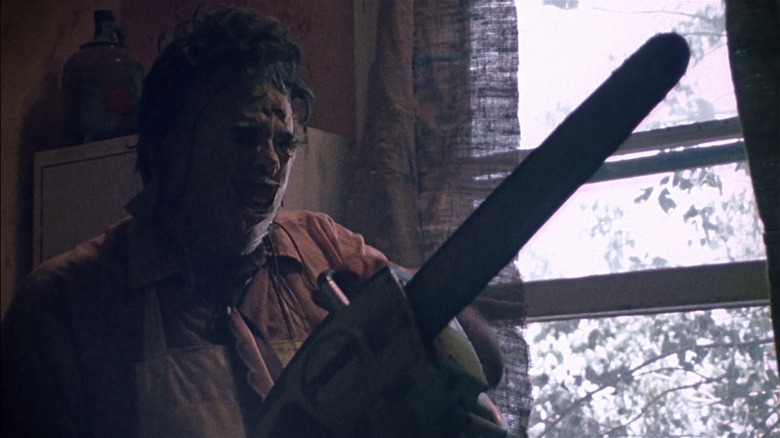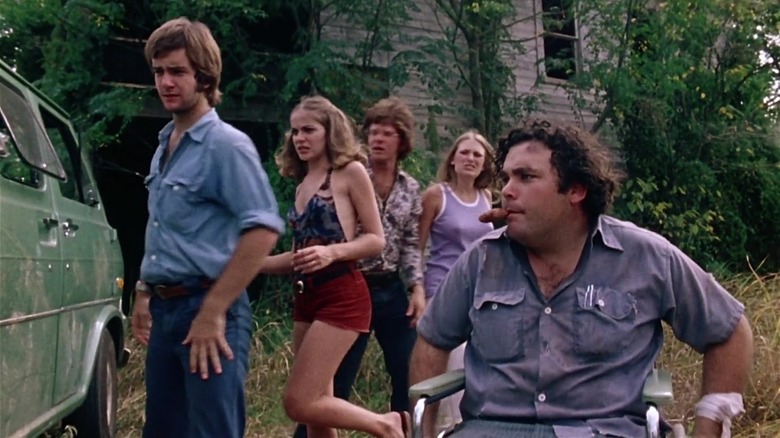The Texas Chain Saw Massacre Led To Injuries For Nearly The Entire Cast
Tobe Hooper's 1974 horror film "The Texas Chain Saw Massacre," just by its very aesthetic, is one of the grimier, more disgusting movies ever made. Shot on 16mm film, every frame looks stressed and overexposed, as if the film stock itself had been stored in a slaughterhouse. It's a film that looks like it was made by the killers who live inside of it.
The mythology of "The Texas Chain Saw Massacre" is well-known to all horror aficionados, and has inspired a massive subgenre of feckless city dopes who get lost in the impoverished backwoods of America only to be slaughtered by the mutated locals. The film stands as a commentary on the great forgotten swaths of the United States, shoved aside by economic hardship and a lack of resources. In most cases, the forgotten people turn to cannibalism to survive. The poor feed on the well-to-do.
The film itself is a mere litany of torture and misery. The backwoods cannibals stalk from their home to hunt the traveling city folk. They are each killed horribly, getting stabbed, cleavered, and hung on meat hooks. The final survivor has the dubious honor of seeing her blood sucked straight from her finger by a half-dead 100-year-old cannibal patriarch. A fun piece of trivia: the blood tube for the finger-cutting scene wouldn't work on the day of shooting, so actress Marilyn Burns actually cut her finger open. That was real blood.
In 2004, Texas Monthy Magazine looked back on the production and the influence of Tobe Hooper's horror standard-setting classic, and found that the filming and production of "Chain Saw," while not quite as harrowing as what the characters experience, was still a trial for the actors. It seems almost no one in the cast escaped the film without sustaining a real injury.
Killing me gently
Early in the film, a van full of city folk picks up a scary, crazed hitchhiker played by Edwin Neal. According to Texas Monthly, Neal fell over on the road during production. The fall wasn't injurious, but the weather was so unbearably hot, that when Neal's face hit the pavement, it burned. Actor Paul A. Partain played the character of Frank, who, early in the film, tumbles down a small hill. Evidently, the fall caused him to bruise and cut one of his arms.
Perhaps most recognizable, the towering Gunnar Hansen played the chainsaw-wielding brute nicknamed Leatherface. Because he had to wear a mask, Hansen's visibility was cut off, which is a bad situation to be in when operating a real chainsaw. The story goes that Hansen, unable to see the floor, slipped in a puddle of fake blood and fell over, flinging his chainsaw into the air. The chainsaw landed very close to him. Luckily, he was not cut at all.
In addition to cutting her own finger, Marilyn Burns sustained the most injuries. One can see her pain on camera, in fact, as her character was jostled about by the cannibal family, and she had to actually climb through scratching bushes. Some of the cuts are real, and her visible pain was unfeigned. Burns' character also had to be smashed on the head with a hammer in one scene. The props department built a special rubber hammer for the scene, but it still couldn't have been fun to constantly get bashed by a co-star. The old cannibal man was played by Jim Siedow, and he told Texas Monthly that he didn't want to strike Burns for fear of hurting her. Eventually, the filmmakers reached an impact level that looked authentic.
Poor Burns.
Blood
Although Marilyn Burns may have used her real blood in the above-mentioned scene, the bulk of blood on the set of "The Texas Chain Saw Massacre" was fake. It was made of sweetened corn syrup, meaning there was a patina of sticky, sugary slime over many surfaces, mostly the floors. This attracted mosquitos, and many of the cast reported being attacked by clouds of the critters. According to Stefan Jaworzyn's 2004 book "The Texas Chain Saw Massacre Companion," Burns said the blood was so thick and sticky that, by the end of the shoot, her clothes had dried into a solid, unmoving mass.
Hooper eventually spoke out about the dangerous conditions of the set. In a 2014 interview at SXSW, Hooper admitted that everyone on set hated him, and eventually stopped speaking to him altogether. Hooper said, "[I]t just took years for them to kind of cool off." He recalled an additional injury, as well, when Hansen had to strike Bill Vail in the eye with a rubber hammer. Even though it was rubber, Vail still got a black eye.
Hansen also evidently went on record with his hatred for Hooper, as the director recalled:
"I did see a documentary that Gunnar Hansen is in and when he does the chainsaw dance at the end of the film, he said he 'enjoyed that moment because it was his last chance to kill me', because he had the sour growing ... but I think they're all mostly resolved with that, you know, but it was necessary."
Perhaps the difficulty and discomfort on set were the main reasons why audiences are still so viscerally repelled by "Texas Chain Saw" to this day. It certainly makes an already harrowing film that much more unsettling.


